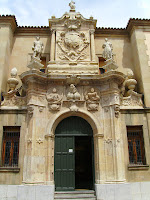


Carrion de los Condes Carrión de los Condes is
a town of 2,302 inhabitants located in the English autonomous community of Castile and Leon, comarca of Tierra de Campos, 40 km from Palencia, the capital which is part of the province, 80 km and 95 km from Burgos to Valladolid is that of a lion. It is situated on a hill on the left bank of the river Carrión on one side and dominates the arid Castilian Meseta, flat, fertile plain of the river on the other Carrión. It was during the Middle Ages an important stage of the Camino de Santiago. By that time kept many Romanesque and Gothic. Today is a rural town whose inhabitants are dedicated mainly to agriculture and pastoralism, and there are some small manufacturing industries.
June 27, 2011 Terradillos El Burgo Ranero Km.36, 6
terradillos DE LOS Templares
Hamlet on the edge of the province of Leon and Palencia, located on a colle.di origin of the late Roman period in the peninsula (sixth century AD) from the Middle Ages is through the chimney flu Santiago.Zona temple, there was a refuge for pilgrims guarded by the Knights Templar
June 28, 2011
El Burgo Ranero Leon Km.37, 1 (tot.463.4)
Burgo Ranero
El Burgo Ranero is a town of 854 inhabitants located in the English autonomous community of Castilla The town is a cluster of houses put a little random, a typical agricultural village. Some of these stable and some are built in
way: clay mixed with straw and stones. Clearly, someone has collapsed. In the evening you can find out why the name: in the pond that supports the country begins a concert of frogs that seems to be the end of the world.
LEON Leon is a town of about 140 000 inhabitants. It 's the capital of the homonymous province and is part of the autonomous community of Castile and Leon.la city was founded in the first century BC by Roman legion Legio VI from which it derives its name the name of città.Nell 'eleventh century it became famous as a stopping place for pilgrims on their way to Santiago de Compostela.Dopo the thirteenth century was a hive of constant activity of the craft guilds and business that had a huge influence on the government of città.Dal sixteenth century onwards, the city experienced a period of both economic and cultural decline that lasted until the English Civil War which saw the city sided with Franco's.
Leon famous for its cathedral and many other monuments, among which the "Real Colegio de San Isidro" in the mausoleum are buried in the collegiate Kings of Leon, there is a collection of paintings in the Romanesque style. "Casa de Botines" the genius architect Gaudi, who expressed his maximum potential in these famous works in Barcelona.
Leon is famous for its Fiestas, such as during the Easter processions are very similar to those taking place in Seville with thousands of hooded penitents "Nazarenos" in a procession for days. Catedral
called "Pulcra lion" for the beauty and purity of his style, is a masterpiece of High Gothic of Spain.
began in 1255 and ended two centuries later, the facade is flanked by two massive towers of different heights, Gothic that right and the other century, has a gallery of lancet windows topped by a large rose window and spire. and down three beautiful doorways, the middle, Puerto de la Virgen Blanca (the statue of the Virgin on the pillar is a copy, the original is kept inside) is decorated with statues of angels and saints, and is crowned by a " Final Judgement "(in the ear drum) with one hand, terrifying monsters that swallow the damned, some of which are immersed in pots, on the other hand, the representation of the blessed to the right and left Puerta de San Francisco de San Juan Gate. Internal great with three naves.
Plaza Mayor is the heart of the old city, surrounded by narrow streets of the barrio of San Martin full of taverns and mesones (Inns), some dating back to the Consistory Antiguo medioevo.Vi stands the baroque town hall
Basilica of San Isidoro splendid Romanesque church (XI sec.) Consecrated in 1063, commissioned by the King of Leon Ferdinand I to accommodate the body of St. Isidore Seville.
Two portals of Cordero Portada Portada del Perdon and which gives access to the church.
three naves and the Gothic Capilla Mayor know is a Renaissance altarpiece and silver case with the body of San Isidoro.
A door leads outside to the underground crypt where the Panteon de los Reìyes
Hostal de San Marcos Grand Bernesga building on the banks of the river is considered one of the most significant works of the Renaissance The English
Plateresque current complex was built between the sixteenth and the eighteenth century and now houses a hotel in the chain of Paradores
Grande Baroque doorway opens onto a magnificent facade enriched at the bottom of a long base with medallions on which they are portrayed the characters of the ancient world and in English history, the right of the front door of the church engages the sixteenth century whose interior has a Gothic nave.
0 comments:
Post a Comment